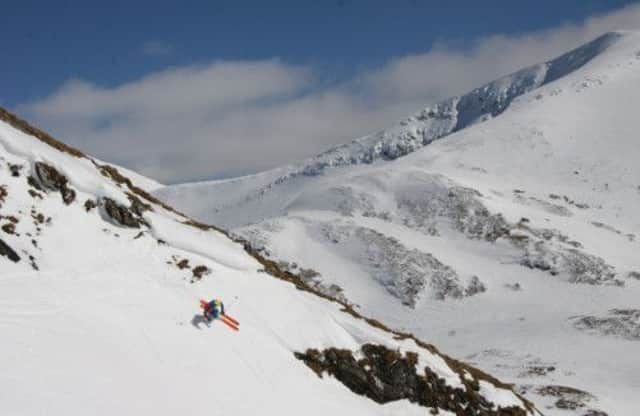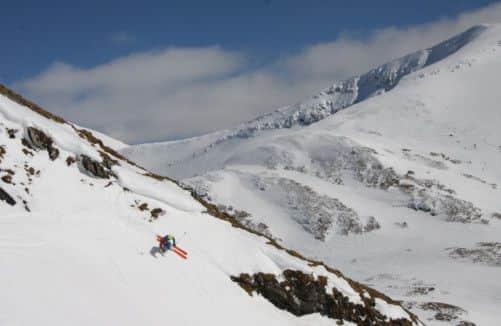Beinn Ghlas - the birthplace of competitive Scottish skiing


It was here, on the north shore of Loch Tay, that the Scottish Ski Club held the country’s first ever slalom race in 1934; here that a few brave souls lined up to take part in Scotland’s first straight downhill race in 1936. The Canadians claim to have invented cat-skiing in the mid-1970s, but no – using a motor vehicle with caterpillar tracks to carry skiers up snowy mountainsides was in fact pioneered on Beinn Ghlas in 1937, when the Scottish Ski Club got their hands on a Citroën Kegresse.
Several key chapters of the history of skiing in Scotland were written on Beinn Ghlas’s slopes, in other words, yet a hiker visiting the hill today could quite easily climb all the way to the summit without being any the wiser. Every now and then, according to locals, an item of antique ski gear will ooze its way up out of the peat, but such finds are becoming increasingly rare.
Advertisement
Hide AdAdvertisement
Hide AdLast spring, a group of Scottish skiers and filmmakers calling themselves the Mountain Goats (of which the author is a token snowboarding member) set up camp at the bottom of Beinn Ghlas for a couple of days, with the intention of making a short film about its all-but-forgotten skiing past. Jo Guest, Jonny Lonie, Lou Sharp and Mark “Sparky” Stewart would do the skiing; Matt Brown, Janeanne Gilchrist and Will Beeslaar would do the filming. Mike Guest would do a bit of both. Armed with Myrtle Simpson’s history of Scottish skiing, Skisters (first published in 1982 and now something of a collector’s item), some flickery 1930s ski footage from the Scottish Screen Archive, and with expert route-finding assistance from mountaineering guides Stuart Johnston and Dave Strachan, we set out to re-ski a couple of the mountain’s historic lines: the course of the Killin Slalom Race of 1934, and the course of the Scottish Kandahar Race of 1936. Then, if we had time, we’d see if we could find something a little more challenging to ski for fun.


As far as anyone knows, skiing in Scotland began on 12 March 1892, when the mountaineer William Wilson Naismith took a pair of long ash boards and a single wooden pole into the Kilsyth Hills and climbed a modest 570m peak known as Meikle Bin. He made the first, gentle part of his descent standing up; then as the gradient increased, he opted to sit down on his skis and use them as a toboggan.
In the early years of the 20th century, skiing in Scotland was still largely the preserve of people who lived in or near the mountains and the few who had the time and money to travel, but between the wars increased car ownership allowed more and more urbanites to sputter their way up into the hills, and Beinn Ghlas – handy for both Edinburgh and Glasgow – became the epicentre of the country’s nascent ski scene. In 1932, the Scottish Ski Club constructed a hut beneath the mountain’s western flank, about an hour’s walk from the road, and this soon became a meeting place for enthusiasts from all over the country. Before long, Beinn Ghlas had turned into such a popular ski destination, and the access road had become so choked with traffic on snowy weekends, that advertisements began to appear in the press politely asking ski nuts to consider alternative locations.
Scotland’s first competitive ski race took place in 1934. Inspired by an address given by the skiing pioneer Arnold Lunn, who had invented slalom racing in Switzerland in 1922, the Scottish Ski Club resolved to hold a contest of their own as soon as conditions were right. Beinn Ghlas was chosen as the venue, and by 10 March there was deemed to be enough snow to hold the event. A report in the Scottish Ski Club Journal states:
“The snow, after being broken up and stamped down, was perfectly good, rather slow and quite easy. Just how easy was soon shown by Patricia Raeburn, who made a flawless descent. For the second run, conditions which had been tolerable became really bad and the intense cold was supplemented by snow falling as well as being blown across the hill, which rendered visibility very poor.”
At a dinner at the Killin Hotel that night, a telegram was dispatched naming Raeburn as the winner of “the first slalom race held in Scotland.” The disparity between the time she achieved for her first run – 20.6 seconds – and the time she achieved for her second – 28 seconds – is a good indication of how much conditions had deteriorated during the day.
When the Mountain Goats set off up Beinn Ghlas, searching for the site of Raeburn’s triumph, the conditions weren’t exactly pleasant either – a stiff wind was blowing in from the east, making the summit ridge an uncomfortable place to linger. On the upside, the wind was also loading the easy-angled west side of the hill with snow, so as the five skiers took turns to ski the line of the Killin Slalom, they found themselves bouncing through a couple of inches of soft powder. Perfectly good, rather slow and quite easy – just like March 1934.
The Goats’ next objective was to ski the south face of Beinn Ghlas, site of the Scottish Kandahar Race of 1936. A straight downhill race had previously been considered too dangerous, but by this point the general standard of skiing had improved significantly, and the members of the Scottish Ski Club decided it was something that could be attempted without too much risk. The south side of the mountain is considerably steeper and more challenging than the west side, however, and as the official report of the race made clear, when they saw what they were going to have to ski, some of the 17 competitors found themselves a long way outside their comfort zones.
Advertisement
Hide AdAdvertisement
Hide Ad“I have often been on Beinn Ghlas,” wrote one unnamed participant, in a letter to the editor of the Scottish Ski Club Journal, “and have even occasionally looked down this south gully, but have always recoiled from the edge of it with a feeling of sick horror, and certainly, the idea of racing down in a mist had never occurred to me, even in my wildest nightmares.”
In spite of the poor visibility, race winner DG Drakeford was able to complete the nerve-jangling 1,250-foot descent in a very respectable time of one minute, six seconds. Visibility wasn’t great when the Mountain Goats visited this part of the mountain either, with low clouds regularly blowing in to engulf the summit. The wind had scoured the gully clean of fresh snow, too, leaving behind nothing but unforgiving hard-pack. Still, the Goats were equal to the challenge, and, channelling the spirit of DG Drakeford, they hit the slope at full-tilt, chattering through turns on edges that barely held.
With the historical element of their mission accomplished, the Goats headed back to camp to make plans for the following day.
Beinn Ghlas is just one of seven Munros in the Ben Lawers range, and every one of these hills offers great ski touring when the conditions are right. As Stuart Johnston points out, in the last few years, “there’s been a real resurgence in off-piste skiing in Scotland” and as a result, Beinn Ghlas has become a playground for a whole new generation of Scottish skiers. The people who ski here now aren’t looking to race each other – they’re in search of steep, challenging terrain to test their skills – and one of the classics in this area is the 35-degree gully that runs down the middle of the east face of Meall Corranaich, the hill just to the west of Beinn Ghlas. It didn’t take the Goats very long to settle on this as their Day Two objective, as it had been staring them in the face for most of Day One.
Scottish skiers are fond of saying that their hills can be “as good as anywhere in the world” when the weather plays ball, and as if to prove the point, the next morning the Goats awoke to find Meall Corranaich looking truly world-class, its central gully stuffed full of shredable soft spring snow beneath an almost completely cloudless sky. Realising that the weather could turn at any moment, there was a frantic scramble to get ski boots on and backpacks packed, a rapid, lung-bursting ascent – and then an afternoon of absolute bliss, as the Goats took it in turns to hammer down their own private ski slope, catch their breath, and then slog back up for another go.
The old Scottish Ski Club hut between Beinn Ghlas and Meall Corranaich was damaged by a storm in 1999, and the decision was made to burn what was left of it rather than carry out repairs or construct a replacement. On the way back to camp, as we skied past the site it used to occupy, I scanned the ground for remains, but couldn’t see any.
The last physical traces of Beinn Ghlas’s proud skiing history, then, have vanished. All the more reason to keep re-telling its remarkable story.